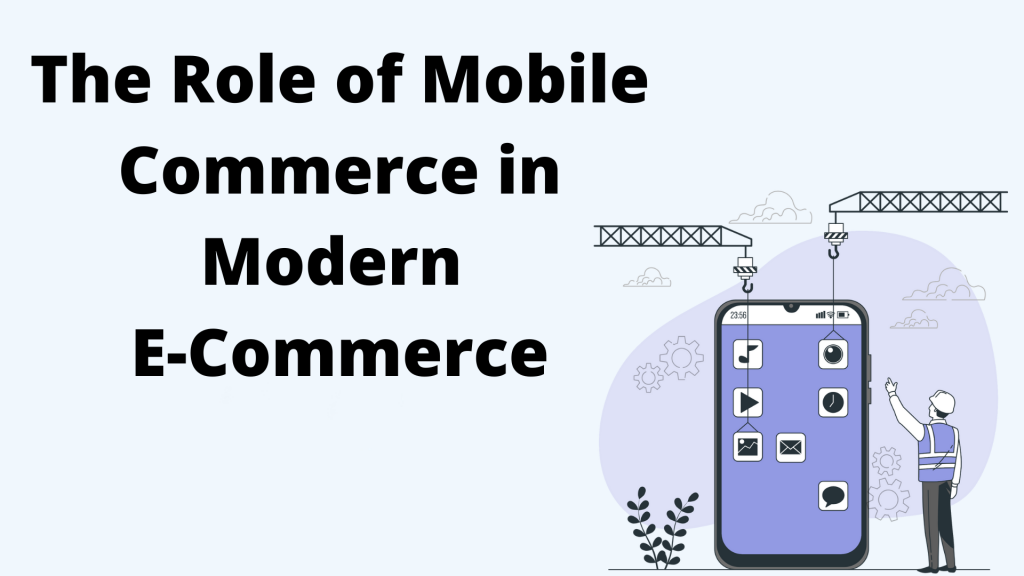
Mobile commerce, commonly referred to as m-commerce, is the buying and selling of goods and services through mobile devices, such as smartphones and tablets. With the increasing popularity and widespread adoption of mobile devices, m-commerce has become an integral part of modern e-commerce. This form of electronic commerce allows potential customers to conveniently shop online using their mobile phones and make purchases through mobile wallets or other digital payment methods. M-commerce can take place via mobile websites or dedicated mobile applications, providing a seamless and personalized shopping experience for mobile users. The role of mcommerce in modern e-commerce is continuously evolving, driven by technological advances and the changing preferences of consumers who are increasingly relying on their handheld devices for various tasks, including online shopping. As a result, online retailers are actively embracing mobile commerce strategies, optimizing their mobile websites and apps, and leveraging social media platforms to attract and engage mobile users, thereby enhancing their customer experience and boosting retail sales.
Benefits of Mobile Commerce
Mobile commerce, also known as m-commerce, has become an integral part of modern ecommerce. With the increasing use of mobile devices, mobile commerce offers several benefits that enhance the online shopping experience for consumers. One major advantage of mobile commerce is better mobility. Customers can access online stores and make purchases at any time and from anywhere using their mobile phones or other handheld devices. This convenience eliminates the need to visit physical stores, allowing customers to save time and effort. Moreover, mobile commerce provides an improved customer experience. Mobile websites and applications are designed specifically for mobile users, offering a user-friendly interface and seamless navigation. This personalized shopping experience leads to higher customer satisfaction and loyalty. In terms of security, mobile commerce employs advanced technologies to protect customer data and ensure secure transactions. Mobile wallets and payment methods, such as credit cards and debit cards, offer secure and encrypted payment processing, giving customers peace of mind when making purchases. Additionally, mobile commerce facilitates stronger omnichannel integrations. Online retailers can connect their mobile commerce platforms with social media platforms, creating a seamless shopping experience for customers across various channels. This allows for greater brand exposure and engagement with potential customers. Lastly, mobile commerce includes location tracking features, enabling retailers to offer personalized promotions and recommendations based on a customer's location. This targeted approach enhances the customer journey and provides a more tailored shopping experience. In conclusion, mobile commerce brings better mobility, improved customer experience, stronger security, stronger omnichannel integrations, and location tracking features. These benefits make m-commerce an essential aspect of the e-commerce business, providing a convenient and secure platform for online shopping.

Mobile Commerce Trends
Mobile commerce trends are constantly evolving as technology advances and consumer behavior changes. One of the key trends in mobile commerce is the rise of mobile payment apps and digital wallets. With the increasing popularity of platforms like Apple Pay, Google Pay, and Samsung Pay, more and more customers are opting for cashless transactions and using their smartphones to make payments. Another trend in mobile commerce is the integration of social commerce. Social media platforms are becoming powerful tools for online retailers to reach and engage with potential customers. By incorporating buy buttons and shoppable posts, businesses can enable seamless transactions directly within social media apps. Additionally, mobile commerce is seeing a shift towards personalized shopping experiences. This involves leveraging user data and tracking to offer tailored recommendations, promotions, and offers to customers based on their preferences and location. Overall, as mobile usage continues to grow, businesses must stay tuned to these trends and adapt their strategies to provide a seamless and convenient mobile shopping experience for their customers.
Growing Popularity of Smartphones
The growing popularity of smartphones has had a significant impact on mobile commerce. With more and more people using their smartphones for everyday activities, including online shopping, businesses have had to adapt to this shift in consumer behavior. Smartphones have become an integral part of people's lives, allowing them to access the internet and make purchases anytime and anywhere. The rise in mobile usage patterns has led to an increase in the number of potential customers for mobile commerce. One of the reasons why smartphones have had such a profound impact on mobile commerce is the advancements in smartphone technology. The introduction of bigger screens has enhanced the online shopping experience, allowing users to view products and details more clearly. This has made it easier for consumers to make informed decisions and engage in online shopping with confidence. In addition to bigger screens, the innovation in mobile apps and technology has also played a crucial role in the growth of mobile commerce. Mobile applications offer convenience and user-friendly interfaces, making it easier for customers to browse and purchase products. Features like personalized recommendations and seamless navigation have grabbed customers' attention and improved their overall shopping experience. Overall, the growing popularity of smartphones and the advancements in mobile technology have reshaped the way we shop online. With bigger screens and innovative apps, the potential for mobile commerce continues to expand, providing both businesses and customers with new opportunities for growth and convenience.
Increasing Use of Mobile Wallets
In recent years, there has been an increased use of mobile wallets in the context of mobile commerce. Mobile wallets, such as Apple Pay and Google Pay, have revolutionized the way customers make in-store purchases, offering them a more convenient and secure payment option. With the integration of mobile wallet technology, customers no longer have to carry physical cash or credit cards. Instead, they can simply use their mobile phones to make payments with just a few taps. This eliminates the need to fumble through wallets or worry about carrying multiple cards, streamlining the checkout process and saving customers valuable time. Furthermore, mobile wallets have expanded their reach beyond traditional brick-andmortar stores. They have now been integrated into social media platforms, allowing users to make seamless purchases directly from their favorite social media apps. This integration has made it even easier for customers to discover and purchase products, without the need to navigate away from their social media feeds. In addition to convenience, mobile wallets offer benefits such as personalized shopping experiences and location tracking via GPS. By securely storing customers' payment information, mobile wallets can provide personalized recommendations based on past purchases, enhancing the overall shopping experience. Moreover, the integration of GPS technology allows mobile wallets to offer location-based offers and promotions, further enticing customers to make purchases. Overall, the increasing use of mobile wallets in mobile commerce has transformed the way customers make purchases, offering convenience, security, and personalized experiences. As mobile technology continues to advance, we can expect to see even more innovations in mobile wallets, further enhancing the customer journey in ecommerce.
Adoption of Social Media Platforms for Shopping
In the ever-evolving world of e-commerce, retailers have recognized the power of social media platforms as an avenue for advertising and promoting their companies. With the rise of mobile commerce (m-commerce), online retailers have seamlessly integrated social media features into their mobile apps and online portals, capitalizing on the expansive reach and engagement potential of these platforms. By leveraging social media platforms, e-commerce retailers have expanded their customer base and increased brand visibility. Users can easily share updates from online websites on their social media accounts, driving mass visibility and engagement. This 2 feature facilitates word-of-mouth recommendations and enables customers to share their shopping experiences with their social network, potentially attracting new customers. Furthermore, the integration of social media features such as liking, commenting, and sharing on mobile apps and online portals enhances customer engagement. Customers can interact with products, leave reviews, and share their purchases with others. This not only creates a sense of community and trust but also helps in generating organic usergenerated content, which serves as valuable social proof for potential customers. In conclusion, the adoption of social media platforms for shopping in the e-commerce sector has revolutionized the way companies advertise and engage with their customers. By leveraging the features and reach of these platforms, retailers can harness the power of social sharing and drive mass visibility and engagement for their products and services.
Customers’ Perspective on Mobile Commerce
When it comes to mobile commerce, the perspective of customers is crucial. In recent years, the proliferation of mobile devices, particularly smartphones, has transformed the way people shop online. With mobile commerce, customers now have the freedom to browse and make purchases anytime and anywhere, providing a convenient and seamless shopping experience. Mobile commerce also offers a personalized shopping experience, with mobile apps and websites tailoring recommendations and offers based on individual preferences and purchase history. The availability of mobile wallets and the ease of mobile payments further enhance the customer experience, allowing for quick and secure transactions without the need for physical credit or debit cards. Moreover, mobile commerce enables customers to easily compare prices, read reviews, and make informed purchase decisions while on the go. As a result, mobile commerce has become increasingly popular among consumers, driving substantial growth in online sales and changing the landscape of e-commerce industry.
Advantages for Potential Customers
Mobile commerce, or m-commerce, offers several advantages for potential customers, greatly enhancing their overall shopping experience. One of the key benefits is the convenience it provides. With mobile devices like smartphones becoming an essential part of our lives, individuals can now shop anytime and anywhere, without being limited to physical store hours. M-commerce also provides access to a wider range of products. Online retailers offer a vast selection of items, making it easier for customers to find exactly what they need. This broader choice allows shoppers to compare different options and make more informed purchasing decisions. Furthermore, m-commerce saves valuable time. Rather than commuting to brick-andmortar stores and waiting in line, customers can browse and make purchases with just a few taps on their mobile phone. This efficient process frees up time for other activities. User-generated reviews are another advantage of m-commerce. Mobile websites and applications often feature customer reviews, enabling potential buyers to gain insights from other users' experiences. These reviews help in evaluating product quality and customer satisfaction. Additionally, customers can benefit from sales promotions specific to mobile commerce. Online retailers frequently offer exclusive discounts and incentives to mobile users, making their purchases more affordable. In conclusion, m-commerce improves the shopping experience for potential customers through its convenience, wider range of products, time-saving nature, user-generated reviews, and sales promotions. Embracing mobile commerce allows individuals to enjoy a seamless and personalized shopping experience, ultimately enhancing customer satisfaction.

Improved Customer Experience
Improved customer experience is of utmost importance in the context of mobile commerce. A well-designed mobile app can significantly enhance the overall buying process and increase conversion rates. A user-friendly interface, intuitive navigation, and seamless functionality are key aspects of a successful mobile commerce app. By incorporating personalized discounts and promotions, customers feel valued and engaged, leading to a higher likelihood of making a purchase. Social media integrations allow users to easily share and recommend products, expanding brand awareness and driving more traffic to the app. One crucial feature that mobile commerce apps should have is a variety of secure and convenient payment options. By offering options such as credit card, debit cards, and mobile payment apps, customers have the flexibility to choose their preferred method, further improving the purchasing experience. The impact of a positive customer experience on revenue generation cannot be overstated. Satisfied customers are more likely to become repeat buyers and recommend the app to others, thus increasing customer loyalty and brand reputation. A good customer experience also reduces cart abandonment rates, improving conversion rates and ultimately leading to higher sales and revenue. In conclusion, by focusing on improved customer experience through features such as personalized discounts, social media integrations, and various payment options, mobile commerce apps can enhance the overall buying process, increase conversion rates, and drive revenue growth in the increasingly competitive mobile commerce landscape.
Loyalty Programs and Incentives for Customers
Loyalty programs and incentives play a crucial role in enhancing customer engagement and encouraging repeat purchases in the context of mobile commerce. These strategies not only help retain existing customers but also attract new ones, ultimately contributing to the growth of the business. By implementing loyalty programs, such as points-based systems, mobile commerce apps can reward customers for their continued loyalty. As customers earn points with each purchase, they are motivated to make repeat purchases to accumulate more points and unlock exclusive benefits. This not only increases customer engagement but also creates a sense of exclusivity and value, fostering a stronger connection between the customer and the brand. Exclusive discounts are another effective incentive that can be offered through mobile commerce apps. By providing special discounts and offers to loyal customers, businesses can create a sense of appreciation and reward, further incentivizing repeat purchases. These exclusive deals can be tailored to suit the individual preferences and purchasing behavior of each customer, personalized offers can be sent to customers based on their browsing and purchase history. Referral programs are also popular in mobile commerce. By encouraging satisfied customers to refer the app to their friends and family, businesses can increase brand awareness and acquire new customers. In return for their referral, customers can be rewarded with additional points, discounts, or other incentives, further incentivizing them to spread the word about the app. Overall, loyalty programs and incentives are effective strategies for enhancing customer engagement and encouraging repeat purchases in mobile commerce. By implementing points-based systems, exclusive discounts, referral programs, and personalized offers, businesses can create a strong and loyal customer base, ultimately driving growth and success in the mobile commerce industry.
Impact on Online Retailers
The impact of mobile commerce (m-commerce) on online retailers cannot be underestimated. With the increasing number of mobile users, online retailers must optimize their websites and develop mobile commerce platforms to cater to this growing segment of consumers. Mobile commerce has revolutionized the way people shop, allowing them to make purchases anytime and anywhere using their smartphones or other handheld devices. This convenience has led to a significant increase in online sales, as customers can browse and purchase products with just a few taps on their mobile phones. Online retailers must also adapt to mobile commerce trends, such as integrating mobile payment apps and digital wallets into their websites and apps, to provide seamless and secure payment options for their customers. Additionally, mobile commerce offers the opportunity for personalized shopping experiences, as retailers can use customer data to tailor offers and recommendations to individual users. By embracing mobile commerce, online retailers can reach a broader audience, enhance the customer journey, and ultimately increase sales and customer satisfaction.
Cost Savings with Digital Wallet or Mobile Apps
In today's digital age, online retailers are constantly seeking ways to streamline their operations and achieve cost savings. One effective strategy is to utilize digital wallets or mobile apps for mobile commerce. By integrating digital wallet technology into their platforms, online retailers can streamline payment processes and reduce transaction fees. With these technologies, customers can easily make purchases using their mobile devices, eliminating the need for physical credit cards. This not only simplifies the checkout process but also reduces the costs associated with manual payment processing. Furthermore, digital wallets or mobile apps offer several advantages for both the retailer and the customer. For retailers, these technologies enable them to gather valuable data and insights on customer behavior, allowing them to personalize the shopping experience and increase customer loyalty. Mobile apps also provide a direct channel for marketing and communication with customers, further enhancing engagement and driving sales. For customers, digital wallet or mobile app payment methods offer convenience, speed, and security. With just a few taps on their mobile devices, users can quickly and securely complete transactions, eliminating the need to manually enter credit card information for each purchase. This enhances the overall shopping experience and encourages repeat business. In conclusion, incorporating digital wallets or mobile apps into mobile commerce strategies helps online retailers achieve cost savings by streamlining payment processes, reducing transaction fees, and eliminating the reliance on physical credit cards. This technology not only benefits the retailer in terms of efficiency and cost-effectiveness, but also enhances the overall customer experience.
Enhanced Reach and Visibility in the Market
Mobile commerce, or m-commerce, plays a significant role in enhancing the reach and visibility of businesses in the market. With the widespread ownership of smartphones, businesses have the opportunity to enter new markets and reach a much larger user base. By embracing m-commerce, businesses can tap into the growing number of smartphone users who prefer shopping on their mobile devices. This not only allows businesses to expand their customer base but also enables them to target a specific audience through personalized marketing and promotions. By leveraging the capabilities of m-commerce apps, businesses can enhance their visibility and attract potential customers in new geographic locations. M-commerce apps offer scalability and marketing advantages that traditional methods often lack. Businesses can utilize these apps to reduce campaign costs by targeting specific user segments with personalized offers and promotions. Additionally, mcommerce apps provide access to social media platforms, allowing businesses to further promote their products or services to a broader audience. The benefits of reduced marketing costs and effective campaigns extend beyond cost savings. M-commerce provides businesses with detailed customer data and insights, enabling them to tailor their marketing strategies and improve customer engagement. By understanding customer preferences and behaviors, businesses can create a personalized shopping experience, increasing customer satisfaction and loyalty. In summary, m-commerce enhances reach and visibility in the market by allowing businesses to enter new markets and access a larger user base through smartphone ownership. M-commerce apps offer scalability and marketing advantages, reducing campaign costs and utilizing social media platforms for promotion. By leveraging mcommerce, businesses can benefit from reduced marketing costs, effective campaigns, and access to detailed customer data, ultimately enhancing their overall visibility and market reach.
Easier Management with Mobile Websites & Applications
In the fast-paced world of e-commerce, mobile websites and applications have become integral tools for online retailers. These platforms offer numerous benefits and advantages that streamline the management process and contribute to the success of businesses in the e-commerce industry. Firstly, mobile websites and applications provide online retailers with the ability to manage their businesses from anywhere at any time. With mobile access, retailers can easily monitor inventory levels, track sales, and manage orders on-the-go. This flexibility eliminates the need for retailers to be tied down to a physical location and allows them to stay connected to their businesses on handheld devices. Additionally, mobile websites and applications simplify the management process by providing real-time analytics and reports. Retailers can access key performance indicators, such as conversion rates, customer behavior, and sales trends, which enable them to make informed decisions and adjust their strategies accordingly. These insights empower retailers to optimize their operations and maximize their profitability. Moreover, mobile websites and applications contribute to the overall customer experience by making online shopping more convenient and accessible. With a responsive mobile website or a dedicated mobile app, customers can easily browse products, make purchases, and track their orders on their smartphones or tablets. This seamless experience not only enhances customer satisfaction but also encourages repeat business and fosters customer loyalty. In conclusion, mobile websites and applications play a crucial role in the e-commerce industry by simplifying the management process for online retailers and improving the overall customer experience. By leveraging these platforms, businesses can achieve easier management, gain valuable insights, and deliver exceptional service, ultimately driving their success in the competitive e-commerce landscape.

Challenges Faced by the E-Commerce Industry Today in Relation to MCommerce
The e-commerce industry today faces several challenges when it comes to m-commerce, mainly due to the mobile nature of transactions. One significant challenge is security concerns. Mobile devices are more vulnerable to security breaches and cyber attacks, putting customer data and financial information at risk. Online retailers must implement robust security measures, such as encryption and two-factor authentication, to protect customer data and ensure secure mobile transactions. Another challenge is the limitations regarding mobile website design. Mobile screens are smaller, which means that websites need to be optimized for smaller displays and touch navigation. This can sometimes result in a compromised user interface and a less visually appealing experience. Online retailers must invest in responsive design techniques to ensure their websites are mobile-friendly and offer a seamless browsing and purchasing experience across different devices. Compatibility issues with various mobile devices add to the challenges faced by the ecommerce industry in m-commerce. With numerous operating systems, screen sizes, and browsers, ensuring that a website or application functions properly on all devices can be a daunting task. Online retailers need to conduct extensive testing and optimization to ensure compatibility across a wide range of mobile devices to avoid frustrating experiences for potential customers. Lastly, optimizing the mobile shopping experience is crucial. Online retailers must focus on creating a user-friendly shopping journey that is intuitive, easy to navigate, and offers quick load times. The mobile shopping experience should be streamlined and conducive to completing purchases efficiently on mobile devices. By addressing these challenges head-on, the e-commerce industry can continue to harness the potential of m-commerce and cater to the growing number of mobile users. So keep these challenges in mind and embrace the opportunities that lie within the realm of mobile commerce.
 Mobile commerce, commonly referred to as m-commerce, is the buying and selling of goods and services through mobile devices, such as smartphones and tablets. With the increasing popularity and widespread adoption of mobile devices, m-commerce has become an integral part of modern e-commerce. This form of electronic commerce allows potential customers to conveniently shop online using their mobile phones and make purchases through mobile wallets or other digital payment methods. M-commerce can take place via mobile websites or dedicated mobile applications, providing a seamless and personalized shopping experience for mobile users. The role of mcommerce in modern e-commerce is continuously evolving, driven by technological advances and the changing preferences of consumers who are increasingly relying on their handheld devices for various tasks, including online shopping. As a result, online retailers are actively embracing mobile commerce strategies, optimizing their mobile websites and apps, and leveraging social media platforms to attract and engage mobile users, thereby enhancing their customer experience and boosting retail sales.
Mobile commerce, commonly referred to as m-commerce, is the buying and selling of goods and services through mobile devices, such as smartphones and tablets. With the increasing popularity and widespread adoption of mobile devices, m-commerce has become an integral part of modern e-commerce. This form of electronic commerce allows potential customers to conveniently shop online using their mobile phones and make purchases through mobile wallets or other digital payment methods. M-commerce can take place via mobile websites or dedicated mobile applications, providing a seamless and personalized shopping experience for mobile users. The role of mcommerce in modern e-commerce is continuously evolving, driven by technological advances and the changing preferences of consumers who are increasingly relying on their handheld devices for various tasks, including online shopping. As a result, online retailers are actively embracing mobile commerce strategies, optimizing their mobile websites and apps, and leveraging social media platforms to attract and engage mobile users, thereby enhancing their customer experience and boosting retail sales.





